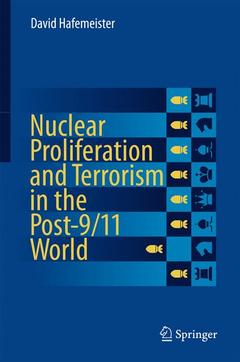Description
Nuclear Proliferation and Terrorism in the Post-9/11 World, Softcover reprint of the original 1st ed. 2016
Author: Hafemeister David
Language: English
Subjects for Nuclear Proliferation and Terrorism in the Post-9/11 World:
Keywords
National Security Text; Nuclear Arms Textbook; Nuclear Economics; Nuclear Proliferation Policy; Nuclear Proliferation Textbook; Nuclear Weapons History; Nuclear Weapons Policy Courses; Nuclear Weapons Post-9/11; Physics Behind Arms Control Treaties; Physics of Nuclear Proliferation; Physics of Nuclear Weapons; Post-9/11 Nuclear Proliferation
Publication date: 04-2016
Support: Print on demand
Publication date: 04-2018
Support: Print on demand
Description
/li>Contents
/li>Biography
/li>Comment
/li>
This book fills a clear gap in the literature for a technically-focused book covering nuclear proliferation and related issues post-9/11. Using a concept-led approach which serves a broad readership, it provides detailed overview of nuclear weapons, nuclear proliferation and international nuclear policy. The author addresses topics including offensive and defensive missile systems, command and control, verification, weapon effects, and nuclear testing. A chronology of nuclear arms is presented including detailed discussion of the Cold War, proliferation, and arms control treaties.
The book is tailored to courses on nuclear proliferation, and the general reader will also find it a fascinating introduction to the science and strategy behind international nuclear policy in the modern era.
1. History of the Atomic Age.
1.1. Survey of Events. 1.2. Conflict Literature. 1.2. Nuclear Arms Chronology.
2. Nuclear Weapons.
2.1. The Nuclear Age. 2.2. Nuclear Proliferation. 2.3. Fission Energy. 2.4. Critical Mass. 2.5. Neutron Generations, Yield. 2.6. Plutonium Implosion Weapons. 2.7. Boosted Primaries, H–Bombs. 2.8. Neutron Bomb. 2.9. Exotic Weapons. 2.10. Nuclear Weapon Effects. 2.11. EMP Attack on Power Grid. 2.12. Stockpile Stewardship.
3. Nuclear Reactors and Radiation.
3.1. Nuclear Reactors. 3.2. Nuclear Safety. 3.3. New Reactor Designs. 3.4. Low–Dose Radiation. 3.5. Radiation Standards. 3.6. Weapon Accidents and Indoor Radon.
4. Missiles and War Games.
4.1. Rocket Motion. 4.2. ICBM Accuracy. 4.3. Kill Probability. 4.4. Launch on Warning? 4.5. Nuclear Conflict and MAD. 4.6. Conventional Conflict.
5. Ballistic Missile Defense.
5.1. ABM History. 5.2. Target Interactions. 5.3. Nuclear ABMs. 5.4. Particle Beam Weapons. 5.5. Laser Weapons. 5.6. Orbital Chemical Lasers. 5.7. Earth-Based Lasers. 5.8. Nuclear Explosion X-ray Laser. 5.9. Kinetic Kill Vehicles. 5.10. Airborne Laser. 5.11. Anti-Satellite Weapons.
6. Verification and Arms Control Treaties.
6.1. Verification Context. 6.2. Arms Control Treaties. 6.3. Optical Reconnaissance. 6.4. Radar Monitoring. 6.5. How Much Verification is Enough?
7. Winding Down the Cold War.
7.1. Then and Now. 7.2. Controls on Warheads and Fissile Materials. 7.3. Warhead Monitoring in INF and START. 7.4. Post Cold–War Initiatives. 7.5. Initiatives to Limit Fissile Materials. 7.6. Warhead Monitoring after START. 7.7. Quo Vadis after Cold War.
8. Nuclear Proliferation.
8.1. Proliferation History. 8.2. The NPT. 8.3. Non-Proliferation Policy.
9. Proliferation Technologies.
9.1. Special Nuclear Material. 9.2. Uranium Enrichment. 9.3. Uranium Details. 9.4. Plutonium Details. 9.5. Missile Technologies. 9.6. Safeguard Technologies.
10. Proliferated States.
10.1. Technology Transfer. 10.2. Five P–5 NWS. 10.3. Four Defacto NWS. 10.4. Iran, a Work in Progress. 10.5. Nine NNWS Successes. 10.6. Eight more NNWS Successes.
11. Nuclear Testing and the NPT.
11.1. Comprehensive Nuclear–Test–Ban Treaty. 11.2. NPT–CTBT Connection. 11.3. Nuclear Tests in Atmosphere and Space. 11.4. Underground Nuclear Tests. 11.5. National Academy on CTBT Monitoring. 11.6. Covert Cavity Tests.
12. Terrorism.
12.1. Terrorism in 21st Century. 12.2. Attack of 11 September 2001. 12.3. Long–Term Response. 12.4. Vulnerability to Terrorism. 12.5. Insider Threats.
13. Nuclear Terrorism.
13.1. Improvised Devices. 13.2. Improvised Nuclear Devices. 13.3. Dirty Bombs. 13.4. Nuclear Industry. 13.5. Drones.
14. Cyber Terrorism.
14.1. Cyber Introduction. 14.2. Stuxnet. 14.3. Cyber Details. 14.4. Cyber Governance. 14.5. Cyber Diplomacy.
15. Biological and Chemical Weapons.
15.1. BW History. 15.2. BW Control with BWC. 15.3. CW History. 15.4. CW Control with CWC.
A. Reflections on Nuclear Arms Control.
A.1. Soviet–American Back-Channel. A.2. Strategic Arms Reduction Treaty. A.3. Conventional Forces in Europe Treaty. A.4. Cold War Ends. A.5. Soviet Union’s Final Days. A.6. Monitoring Warhead Destruction. A.7. Ratification of START. A.8. Verification Standard for START. A.9. Nuclear Test Ban Treaties.
B. Reflections on Nuclear Proliferation.
B.1. Selected Proliferation History. B.2. Nuclear Proliferation Policy. B.3. Nuclear Export Legislation. B.4. Sanctions Legislation. B.5. Nuclear Fuel Cycle Issues. B.6. End of US Plutonium Economy. B.7. Response to US Non–Proliferation Policy.
C. Glossary.
D. Index.
David Hafemeister is Professor (emeritus) of Physics at Cal Poly University. He was employed on national security matters by Senator John Glenn (1975-77), State Department (Special Assistant to Under Sec. of State on nuclear proliferation, 1977-79, 1987), Senate Committees on Foreign Relations (1990-92) and Governmental Affairs (1992-93), Arms Control and Disarmament Agency (1997), Study Director at the National Academy of Sciences (2000–2) and Stanford University Center for International Security and Cooperation (2005-06). He was the lead SFRC technical staff on the ratification of TTBT, CFE and START. His book, Physics of Societal Issues (Springer, 2007) attempts to quantify what is quantifiable. He was chair of the Los Alamos Nonproliferation-Division Review Committee (2003-06).
Serves as a unique textbook for courses related to nuclear proliferation and nuclear weapon issues and policy
Offers a scientific concept-driven approach with equations kept to the minimum required
Covers key scientific and historical developments whilst also addressing modern issues such as nuclear terrorism
Includes supplementary material: sn.pub/extras




